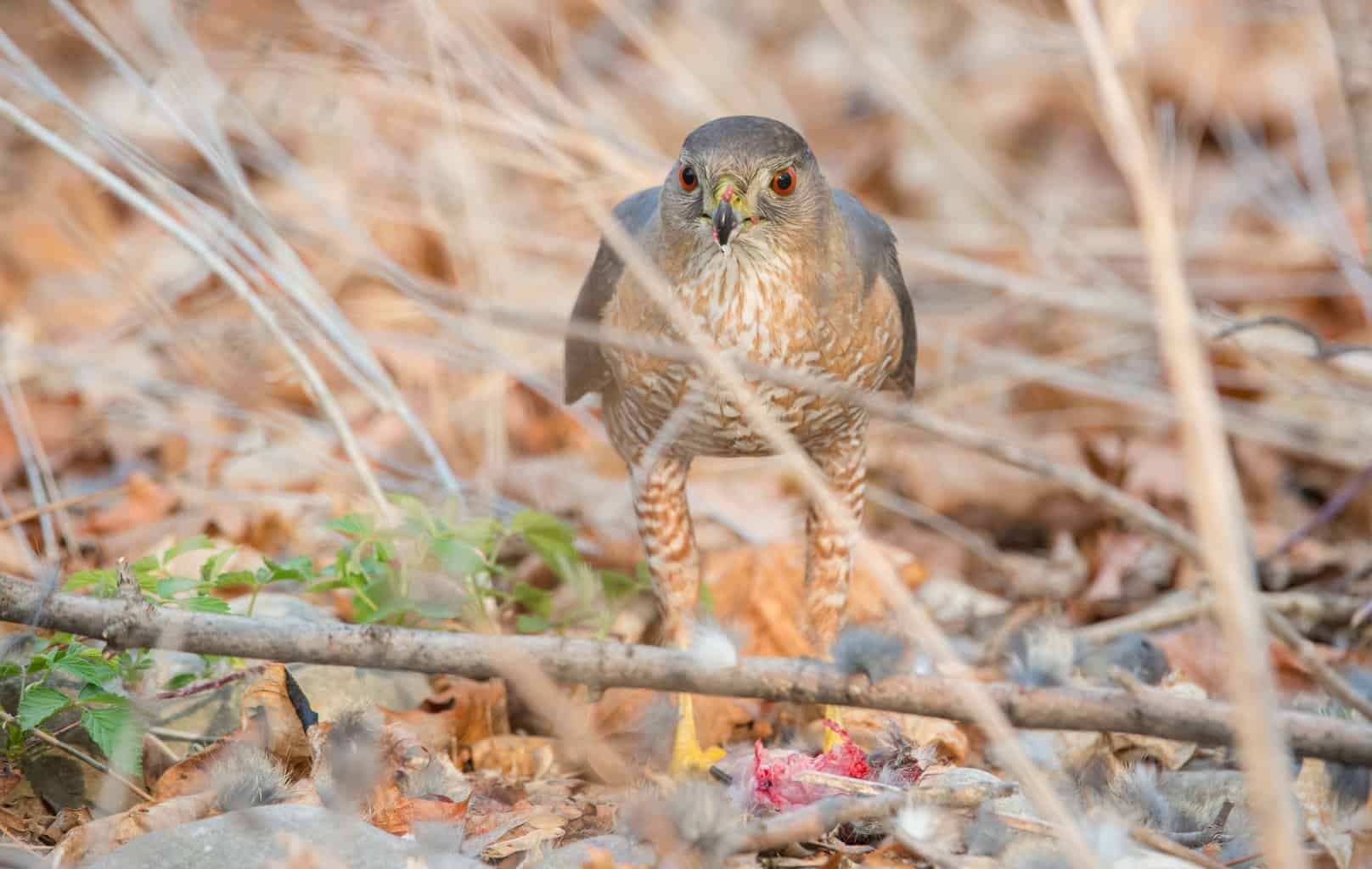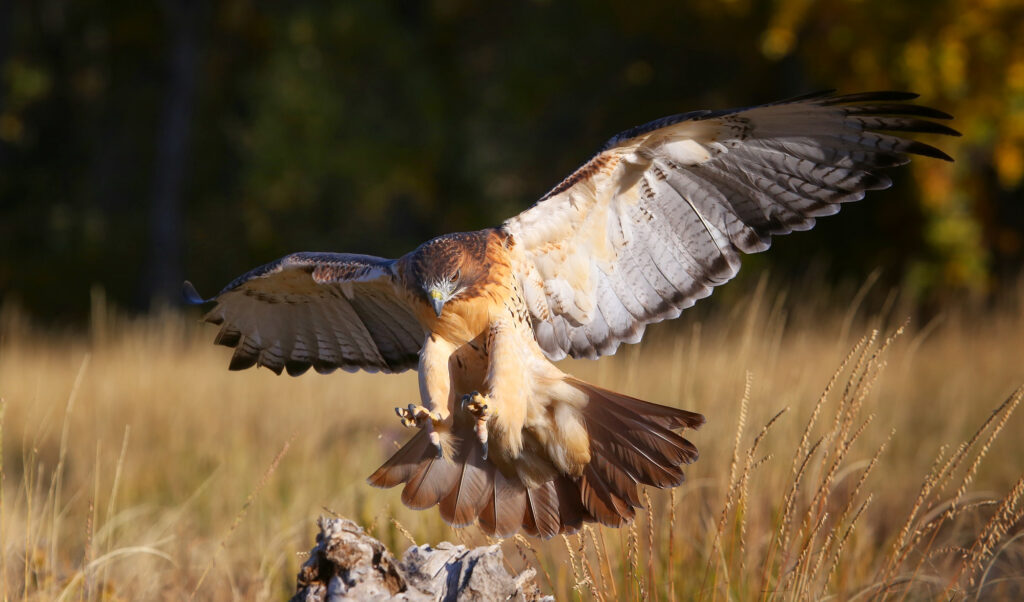North Dakota is home to many great outdoor adventures that are enticing to nature lovers. These include the King’s Walk, Devil’s Lake, Lake Metigoshe State Park, and many more.
If you’re enjoying one of these activities, you’re bound to see one of the 31 types of wild birds that reside there.
Evident in the state’s flag, which features a bald eagle, the “Peace Garden” state boasts such a varied collection of eagles, owls, hawks, falcons, and vultures.
Want to learn more about Hawks in North Dakota? Here’s a list of the 8 species of hawks you may come across!
Accipiter Hawks in North Dakota
Accipiter hawks are identified by their short, rounded wings and narrow tails. They hunt birds and mammals of prey by maneuvering quickly between trees.
Sharp-shinned Hawk

- Scientific name: Accipiter striatus
- Length: 10 – 14 inches
- Weight: 0.25 – 0.5 pounds
- Wingspan: 20 – 26 inches
You can recognize Sharp-shinned hawks by their relatively small head, long body, and yellow legs. Males and females look similar, but females are much larger in size.
These hawks fly with quick, flicking wingbeats. They usually feed on birds but may occasionally eat rodents and bats. They’re most commonly spotted between April and October. You can find them nesting in turtle mountains and wooded areas along rivers.
Cooper’s Hawk

- Scientific name: Accipiter cooperii
- Length: 15 – 18 inches
- Weight: 0.75 – 1 pounds
- Wingspan: 29 – 33 inches
You can identify Cooper’s hawks by their blue-gray back and yellow legs.
An interesting fact about Cooper’s hawks is that their eyes change colors. Their eye color can be yellow, orange, red, or gray, depending on their age and gender.
They prefer hunting medium-sized birds, but they also hunt small mammals. Their flying style is similar to the Sharp-shinned hawk. You’re very likely to spot one in the Pembina Hills. They’ve also recently been spotted nesting in wooded urban areas between April and October.
Northern Goshawk

- Scientific name: Accipiter gentilis
- Length: 19 – 27 inches
- Weight: 2 – 4 pounds
- Wingspan: 40 – 47 inches
This hawk is almost the size of a red-tailed hawk. It’s gray in color and has a black crown and white underparts. It also has a remarkable white stripe over each orange-red eye.
This is by far the biggest and most hostile Accipiter in North America. They prefer hunting rabbits, but they’ve also been seen hunting various other mammals and birds.
Northern Goshawks fly with quick and steady wing beats, followed by a glide. Their females are larger than their males, and the young hawks are mostly brown in color.
Even though they don’t breed in North Dakota, they can be found wintering between October and March.
Buteo Hawks in North Dakota
The Buteos are distinguished by their rounded tails and broad wings. They hunt their prey by soaring high over open areas and then descending rapidly to catch it.
Broad-winged Hawk

- Scientific name: Buteo platypterus
- Length: 13 – 17 inches
- Weight: 0.75 – 1 pounds
- Wingspan: 32 – 36 inches
The Broad-winged hawk is the smallest Buteo. It can be identified by the white band across its black tail. They have a varied diet that includes rodents, reptiles, large insects, and small birds.
These hawks are primarily found in the Turtle Mountains between April and October. They heavily migrate starting mid-April until mid-May. They’re usually spotted in forests where nearby water can be found.
Swainson’s Hawk

- Scientific name: Buteo swainsoni
- Length: 18 – 20 inches
- Weight: 2 – 3 pounds
- Wingspan: 50 – 52 inches
The Swainson’s hawk can be distinguished by the dark bib running from its throat to its mid-breast.
This variety is found state-wide but is especially common in western North Dakota. You can spot it between March and September. They migrate to South America in large flocks during the winter and mainly feed on insects.
Red-tailed Hawk

- Scientific name: Buteo jamaicensis
- Length: 17 – 22 inches
- Weight: 1.5 – 4 pounds
- Wingspan: 43 – 56 inches
The Red-tailed hawk is one of the most popular hawks in North America. Its most distinctive feature is its red tail and white barring on its white belly.
The hawk’s colors range from black and white feathers (Harlan’s variant) to almost a full body of white feathers with a faintly red tail (Krider’s variant).
The Red-tailed hawk can be found between March and October. They’re most commonly found in the Turtle Mountains, across the Missouri Coteau, and all the way to the South Dakota border. They hunt a range of animals such as rodents, snakes, birds, and insects.
They’re able to survive in many different environments, such as grasslands, open green fields, urban areas, and woodlands. Moreover, the introduction of telephone poles in urban cities increased their population since they use them as elevated perches.
Ferruginous Hawk

- Scientific name: Buteo regalis
- Length: 22 – 25 inches
- Weight: 3 – 4 pounds
- Wingspan: 56 inches
The Ferruginous hawk is the largest hawk in North America. It has a pale head and fully feathered legs. It can be identified by its brown upper body and white lower body. Its reddish-brown legs form a contrasting, dark “V” against its white underparts.
The destruction of this hawk’s natural habitat has caused its population to plummet, which has restricted spottings to a limited range in the state. Currently, the Ferruginous hawk can be seen on the Missouri Coteau and in western North Dakota between March and October.
Ferruginous hawks feed on ground squirrels, prairie dogs, and rabbits. Therefore, they prefer living around mixed-grass prairies and shrub steppe.
Rough-legged Hawk

- Scientific name: Buteo lagopus
- Length: 18 – 23 inches
- Weight: 1.5 – 3 pounds
- Wingspan: 48 – 56 inches
The Rough-legged hawk gets its name from the feathers on its yellow legs. It has a dark belly band that contrasts with its light-colored head.
This hawk has small feet that are well-adapted to help it feed on mice, voles, and small birds. It doesn’t breed in North Dakota but spends the winter months in the state. It arrives around mid-October and stays until April.
The Rough-Legged hawk is relatively tame, and people have reported approaching it safely within close range.
Final Thoughts
Seeing a magnificent hawk and being able to identify it is one of the joys of bird lovers.
Watching a soaring bird head toward its prey is one of nature’s most incredible sights.
On your next trip to North Dakota, look out for the beautiful hawks that call it home. You may even spot more types of birds on your adventure!

